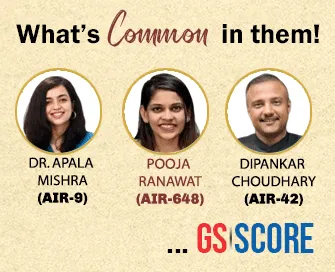

14th August 2023 (10 Topics)
Editorials
Context:
Recently, the Supreme Court (SC) of India directed the Archaeological Survey of India (ASI) to conduct a detailed non-invasive survey of the Gyanvapi mosque in Varanasi. As all scientific techniques have limitations, must be kept in mind while settling a dispute with such significant political implications needs a directive.
Technique to be used by ASI:
- Ground-penetrating radar (GPR) technique: It will be used to produce a 3-D model of buried archaeological features by introducing a short radar impulse from a surface antenna and recording both the time and magnitude of return signals reflected by the property contrasts in the subsoil.
- Seismic and electromagnetic techniques: These are active methods inject energy into the ground and measure the response of the buried target at the surface. They include seismic and electromagnetic
- Measuring physical properties: There are some passive methods, such as magnetometry and gravity surveying, simply measure existing physical properties.
Challenges with these techniques in ‘Gyanvapi’ case:
- Dependence on Non-invasive data: Archaeological investigations are normally performed in open spaces, along with excavation, whereas in the present case, the investigation is being undertaken inside a built structure, and no excavation is permitted.
- Difficulty in identification of distinct physical properties: The methods being used provide an estimate like density, electrical resistance, and wave velocity to get nature and geometry. However many earth materials could have the same physical property and generate the same response on the surface, leading to ambiguity in interpretation.
- May get false images: As a part of the signal may bear little relation to the physical dimensions of the subsurface target, it may create false images.
Points to be taken care of:
- Need of supplementary Data: As the data will always be limited and have measurement errors, it may not be possible to estimate the spatial distribution of physical property in the subsurface. As a result, supplementary information needs to be incorporated.
- To consider financial loss: Despite its inability of geophysical tools to reconstruct the images of targets in the best possible manner, they have a high success rate in resource exploration. But in the case of a failure or partial success, the loss is merely financial.
- Scientific Techniques have limited abilities: GPR or any other geophysical method has limited abilities, and its findings must be interpreted within these contours.


Editorials
Context
The government tabled the Chief Election Commissioner and other Election Commissioners (Appointments, Conditions of Service, Term of Office) Bill in the Rajya Sabha.
Features of the bill
- Appointment Committee- A Bill introduced in the Rajya Sabha says the committee will consist of the Prime Minister, the Leader of the Opposition and a Union Cabinet Minister.
- Search Committee- It proposes a search committee, headed by the Cabinet Secretary, with two other members not below the rank of secretary to prepare a panel of five members for the consideration of the Selection Committee.
- Qualification- CEC and other ECs will be appointed from “amongst persons who are holding or have held a post equivalent to the rank of secretary and who have knowledge of and experience in the management and conduct of elections”.
Misgivings of The Election Commission
- Delayed result- In the runup to the 2019 general election, the announcement of elections was delayed for a month between February and March, allowing the government to inaugurate many projects.
- Model Code of Conduct-The Model Code of Conduct was unevenly implemented, with the ruling party receiving favourable treatment by the ECI, leading to dissent by one of the commissioners.
- Question on Autonomy- The independent VDem Institute in Sweden, which compares democracies worldwide, has downgraded India to an “electoral autocracy”, citing the loss in autonomy of the ECI.
Way Ahead
- Inclusion of a Judicial member - The appointment committee should include the chief justice of India as recommended by the SC and various committees to ensure transparency.
- Unanimous verdict - The collegium system will be all the more credible if a unanimous verdict is added as a precondition to the appointment.
- Consultation - All the organs of the government should be consulted to make the election body like shining armour.


Editorials
Context:
The recent visit of three retired Indian service chiefs to Taipei has sparked media speculation about India's stance and potential actions in the event of a military operation by Beijing to reunify Taiwan with mainland China.
Background and Position of Taiwan in World Order
- Establishment of Taiwan: In 1912, following the fall of the Qing Dynasty, the Republic of China (Taiwan) was established, led by the Kuomintang (KMT).
- Civil War and the Retreat to Taiwan: After the 1949 civil war, the CCP under Mao Zedong took mainland control, and the defeated RoC government, led by Chiang Kai-shek, retreated to Taiwan.
- Taiwan's International Status and the "One China" Policy: Initially in the UN, the RoC lost its seat to the PRC in 1971, with the US maintaining strategic ambiguity since then. The 1972 "Shanghai Communique" acknowledged "one China," with Taiwan as part of it.
India’s relationship with the RoC
- Chiang Kai-shek's Visit and India's Support: During WWII, Chiang Kai-shek's visit to Ramgarh and his address to the Indian National Congress marked a significant moment of support. He also conveyed the cause of India's freedom to Roosevelt.
- India's Shifting Approach to the PRC: India recognized the People's Republic of China (PRC) in 1950 and upheld a "one China" policy. In 1995, trade and cultural ties were established, and diplomatic representatives were posted. There's also a convergence of interest on the Indo-Pacific strategy due to shared concerns about the PRC's expansionist behavior.
- Mutual Interests and Benefits: India and the Republic of China (RoC) have mutual interests, including military intelligence exchange and RoC's semiconductor expertise, fostering a strong partnership.
Way forward
- Caution in Emerging Relationship: As the three former chiefs offer recommendations to the government, New Delhi must exercise caution and skepticism due to historical factors.
- RoC's Controversial Stances: RoC has controversially originated the 9-Dash Line in the South China Sea and rejected the McMahon Line, asserting that "Southern Tibet" belongs to China.
- Common Interests and Strategic Benefits: New Delhi and Taipei share a mutual interest in countering China's South China Sea claims. This partnership can reinforce Taiwan's identity, ensure freedom of navigation in the South China Sea (critical for India's trade), and support India's oil and gas exploration activities in the region.




